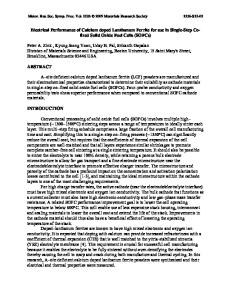Analysis of Electrochemical Performance of Single Step Co-fired Solid Oxide Fuel Cell (SOFC) Analyzed Using Polarization
- PDF / 344,979 Bytes
- 6 Pages / 612 x 792 pts (letter) Page_size
- 71 Downloads / 317 Views
1126-S10-02
Analysis of Electrochemical Performance of Single Step Co-fired Solid Oxide Fuel Cell (SOFC) Analyzed Using Polarization Model and Impedance Spectroscopy Kyung Joong Yoon, Srikanth Gopalan, Uday B. Pal Department of Mechanical Engineering, Division of Materials Science and Engineering, Boston University, Boston, MA 02214, U.S.A. ABSTRACT Anode-supported planar solid oxide fuel cell (SOFC) was successfully fabricated by a single step co-firing process. The cell comprised of a porous Ni + yittria-stabilized zirconia (YSZ) anode support, a porous and fine-grained Ni + YSZ anode active layer, a dense YSZ electrolyte, a fine-grained porous Ca-doped LaMnO3 (LCM) + YSZ composite cathode active layer, and a porous LCM cathode current collector layer. The cell was tested between 700~800oC with humidified hydrogen (97% H2+3% H2O) as fuel and air as oxidant. The measured maximum power densities were 1.42W/cm2 at 800oC, 1.20W/cm2 at 750oC, and 0.87W/cm2 at 700oC. The cell was also tested at 800oC with various compositions of oxidant, and cell parameters including the area specific ohmic resistance, exchange current density, and anodic and cathodic limiting current densities were determined using the polarization model and impedance spectroscopy. INTRODUCTION Although significant improvement of SOFC performance has been achieved in recent years1-3, there is still considerable room for further improvement through the optimization of materials and microstructures. Polarization modeling is a very useful tool to improve the electrochemical performance of SOFC because it provides information on how various materials, microstructures, process parameters, and cell design affect the polarization losses. The high shear compaction process is a ceramic tape fabrication technique developed by Ragan Technologies4, 5, and offers many advantages in SOFC anode manufacturing applications such as low fabrication costs, high production throughput, and good control of shrinkage and thickness compared to conventional tape casting and lamination process. In the present work, the anode-supported SOFC was fabricated by single step co-firing process using high shear compaction anode support, and tested between 700~800oC with various compositions of oxidant. Electrochemical performance of the co-fired cell under various operating conditions was analyzed using polarization model and impedance spectroscopy. EXPERIMENT In high shear compaction process, ceramic powders are mixed in water with binder, and dried to form free flowing granules. The powder granules are then fed into a hopper in the tape fabrication machine, and the machine performs several operations such as uniform dispersion, compaction, edge forming, green density and thickness control, and surface finish4-5. The cells used in the present work were fabricated by the single-step co-firing process using high shear compaction anode as described in detail in our earlier works6-8. The fabrication process involved high shear compaction of the anode support (NiO+YSZ), screen printing of
Data Loading...











